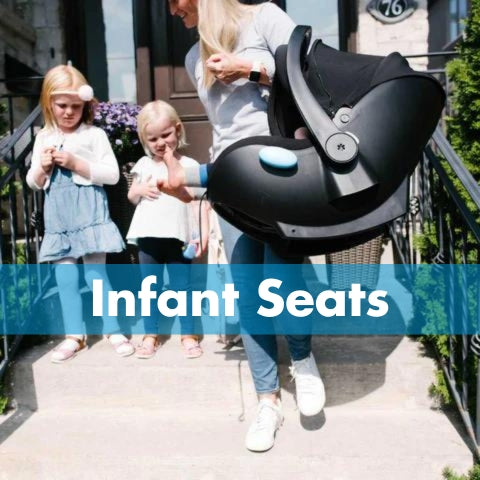If you’ve installed a car seat during the past 18 years, there’s a good chance you’ve either used or wondered curiously about the metal brackets poking out alongside the seat belt buckles in the back seat of the vehicle. We’re talking, of course, about LATCH anchors – also known as UAS and ISOfix (for simplicity’s sake, we’ll refer to it as LATCH for the rest of this article.) And while today they’re a ubiquitous feature that makes the lives of parents and car seat manufacturers a whole lot easier, it hasn’t always been that way.
In fact, prior to the late 90s, they were little more than a strong desire shared by global manufacturers and researchers to establish a universal method of installing car seats securely and easily.
So, whether you’ve long been familiar with LATCH, or have recently found yourself shopping for your little one (and are trying to make sense of the various installation methods), it’s worth taking some time to really delve into why, where, and how and it came to be.
Did You Know?
Unlike seat belts, LATCH was invented with the sole purpose of car seat installation. The use of LATCH often minimizes the margin of error in comparison to a seat belt installation!

A Brief History of LATCH
LATCH (Lower Anchors and Tethers for CHildren) is the international standard designed as an alternative to seat belts to enable quick and secure installations of appropriate child car seats.
The original design featured two metal brackets tucked into the seat bight spaced a standard 11” (280 mm) apart and was meant to be used with rigid lower anchor attachments found on the car seat. Notice we didn’t say anything about top tether anchor points? That’s because this method of limiting forward rotation actually wasn’t a specified requirement at the time.
Though top tethers where already featured on forward-facing child restraints in some countries – including the US, Canada, Australia -- as early as the 1970s, they weren’t readily available in many American vehicles (and were difficult to retrofit). And while their impressive safety stats – plus their ability to solve some of the installation issues plaguing car seats of this era - led to their resurgence in the mid 90s, the US still only RECOMMENDS the use of a top tether for forward-facing child seats. It’s not mandated! Despite that, top tether anchors MUST be in place in new vehicles and MUST be featured on all forward-facing car seats manufactured today.

What LATCH Looks Like Now:
These days, you’ll see a variety of LATCH configurations available on car seats. For instance, the Clek Liing includes an Infant Car Seat Base that offers the Rigid LATCH installation method, while the Clek Liingo includes flexible LATCH connectors engineered into the seat itself. The differences are actually pretty straight forward.
What’s the Difference Between Rigid LATCH and Flexible LATCH?

Rigid LATCH
The car seat connects to the vehicle’s LATCH anchorage system via a “fixed” or “rigid” bracket designed as part of the seat frame.
Flexible LATCH
The car seat connects to the vehicle’s LATCH anchorage system via “flexible” webbing featuring connectors on the end and an adjuster mechanism for adjusting the length. The webbing is routed through the seat's appropriate belt path and then tightened to obtain a tight fit.
LATCH It and Forget It? Not So Fast
While LATCH might sound like the perfect solution, current reality makes things a little more complicated. For starters, you can’t simply install your car seat with LATCH in any vehicle position. Despite the fact that vehicle manufacturers must provide at least two positions featuring lower anchors (typically the outboard seats), most choose to leave it at that. Sorry, middle-seat fans!

What’s more, while you certainly can find some vehicles which feature LATCH anchors in the middle position, they may “borrow” an anchor from one of the outboard seats. In such cases, they won’t necessarily be spaced the standard 11” apart, which can create all sorts of headaches and difficulties with installation. In fact, most car seat manufacturers don’t even allow the use of any anchors spaced more than 11” apart. And in the case of rigid connectors, they simply won’t work if spaced any further.
Further complicating matters, the position and access to the lower anchors will also vary from vehicle to vehicle. Some are readily visible from the seat bight (the point at which the back cushion and seat cushion meet). Some are hidden behind a fabric flap. Some are stored in small plastic housings. Some are even positioned a few inches above the crease. If the seat is a bit firmer, it may even make it tough to fit your hand in to reach the anchor.
That goes for top tether anchors too. Is it on top of the back seat? Behind the back seat? On the roof? Variety isn’t exclusive to location, either, since how to properly route the tether also comes into play in. Some manufacturers dictate to route it under the vehicle headrest, some over, etc. It largely depends on a number of factors, which may leave parents confounded and frustrated.
Wait, wasn’t one of the key goals of LATCH to make things a little simpler?

Determining the Right LATCH Configuration for Your Car Seat and Vehicle
While there’s no one-rule that will apply to every case, your vehicle owner’s manual – combined with your car seat manual – will be your best friends in finding all the necessary information. While most lower anchor points will be highlighted by a button or sticker featuring the below symbol, you can more easily find all anchor locations inside the manual, as well as all needed recommendations.
Still Find Yourself Stuck?
Should you find yourself in a situation where you just can’t be sure, we recommend reaching out to a Certified Child Passenger Safety Technician - or CPST. They can help you puzzle together tricky installations like 3-across. We also offer virtual car seat checks for Clek owners, that can help ensure your little ones are riding right.
LATCH Limits: The Final Factor
So, assuming that you’ve identified the correct LATCH locations for your vehicle, and confirmed car seat fit, there’s one final consideration. Did you know that lower anchors have specified weight limits? Not only that, they will (of course) vary by country, different types of installations, and other factors.
In the US, lower anchor weight limits are calculated as a maximum combined weight of 65 lb[1] between both the child and seat weight, which wasn’t always the case. US regulations came into effect in February 2014 that required car seat manufacturers to list a maximum weight for using the lower anchors based on a chart that utilized the 65 lb limit for all car seats manufactured on or after February 28th, 2014. Before then, lower anchor limits were set by the car seat manufacturer based on their own testing and common limits were 40 or 48 lb child weight limits.
Canada still largely follows this 40/48 lb recommendation, though many Canadian auto makers have adopted the more stringent US regulations. If the LATCH limit listed in your vehicle manual is lower than the car seat’s stated limit, then it is recommended to follow the limit specified in your vehicle manual.
[1] The chart used in the US includes rounding either up or down depending on mode of installation. We’ve kept it simple and not gotten into the specifics of the chart here.
Here’s an example of what LATCH installations are allowed with Foonf in both countries:
CANADA
Rear-Facing
- LATCH installation for children weighing 14 – 40 lb
Forward-Facing
- LATCH and vehicle belt installation (used in combination*) for children weighing 22 – 65 lb
- LATCH installation for children weighing 22 – 48 lb
US
Rear-Facing
- LATCH installation for children weighing 14 – 25 lb
Forward-Facing
- LATCH and vehicle belt installation (used in combination*) for children weighing 22 – 65 lb
- LATCH installation for children weighing 22 – 35 lb

Bet you’re wondering about those asterisks, huh?
Being able to install a forward-facing seat with both Rigid LATCH and a vehicle seat belt at the same time is something unique Foonf, and is otherwise a major car seat no-no. Foonf allows for a combined installation simply because it’s designed with a Rigid LATCH system AND a separate belt path for forward-facing seat belt installation, meaning that one method does not interfere with the other.
Why use both? Using both Rigid LATCH and the vehicle seat belt will allow for the continued safety benefits offered by the enhanced side-impact performance of the Rigid LATCH system, as well as the increased forward-facing safety performance of our REACT crumple technology, while gaining the extra weight capacity of the seat belt.
LATCH: The Journey Continues
Talk about a long and winding road. Even if the reality of LATCH hasn’t quite met the initial promise, it’s undeniable that it provides parents and manufacturers with a valuable tool in keeping kids safe on the road. And, as has been the case through its history, vehicle and car seat manufacturers, along with child passenger safety advocates, will continue to push the standard forward as the journey continues.
The Ride Starts Here
Remember, if you’re a Clek owner with questions about your seat, its safety features, or your installation, we invite you to reach out to our Customer Service team – each of whom are trained CPSTs.
If you’re currently in search of the right seat for your needs, you can join a Clek expert for a virtual product tour and explore seats that combine best-in-class safety with parent-friendly ease-of-use and modern style.
Get Product Specific Support
For more Clek model-specific information about LATCH, including video installation guides and more, visit our help center at: https://support.clekinc.com/hc/en-us




